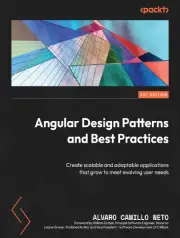
عنوان:
Angular Design Patterns and Best Practices
نویسنده:
Alvaro Camillo Neto
انتشارات:
Packt Publishing Pvt ltd
تاریخ انتشار
2024
حجم:
8.3MB
معرفی کتاب: " الگوهای طراحی و بهترین شیوهها در Angular: ساخت اپلیکیشنهای مقیاسپذیر و سازگار با نیازهای در حال تحول کاربران"
ویژگیهای کلیدی:
- ✔ افزایش بهرهوری در توسعه اپلیکیشنهای Angular از طریق استفاده از ویژگیهای پیشرفته و بهترین شیوههایی که اغلب نادیده گرفته میشوند
- ✔ ارتقای کیفیت اپلیکیشنهای Angular با سادهسازی کد
- ✔ کسب دانش عملی از طریق مثالهای واقعی در مورد ویژگیهای پیشرفته Angular و الگوهای طراحی
- ✔ با خرید نسخه چاپی یا کیندل، نسخه PDF این کتاب نیز در دسترس خواهد بود
توضیحات کتاب:
اپلیکیشنهای تکصفحهای (Single Page Applications - SPAs) به استانداردی برای اغلب تجربههای وب تبدیل شدهاند. Angular، با رویکرد «همهچیز درون بسته»، به فریمورکی قدرتمند برای سادهسازی توسعه این رابطها تبدیل شده و یک جعبهابزار کامل ارائه میدهد.
این کتاب شما را در اکوسیستم Angular راهنمایی میکند، الگوهای طراحی ارزشمند را آشکار میسازد و نحوه استفاده از ویژگیهای اساسی آن را آموزش میدهد.
کتاب با ایجاد یک پایه قوی آغاز میشود و به شما کمک میکند بفهمید که چه زمانی و چرا Angular باید فریمورک انتخابی شما برای توسعه وب باشد. در ادامه، طراحی کامپوننتها و ارتباط بین آنها را بهگونهای خواهید آموخت که نتیجهای انعطافپذیر و پرفورمنسمحور داشته باشد.
سپس به ویژگیهای پیشرفته Angular میپردازید، مانند طراحی فرمهایی امن و مبتنی بر مدل داده تایپشده، پیادهسازی قابلیتهای اشتراکی با interceptorها، و بهرهگیری از معماری Micro Frontend. در نهایت، بر تستنویسی و مدیریت خطا نیز تسلط خواهید یافت.
آنچه خواهید آموخت:
- ✔ کشف راهبردهای مؤثر برای سازماندهی پروژه Angular جهت بهبود کارایی
- ✔ استفاده از قدرت TypeScript برای افزایش بهرهوری و کیفیت کلی پروژه
- ✔ پیادهسازی الگوهای طراحی اثباتشده برای ساختاردهی و ارتباط مؤثر بین کامپوننتها
- ✔ سادهسازی اپلیکیشنهای پیچیده با ادغام Micro Frontend و کامپوننتهای مستقل (standalone)
- ✔ بهینهسازی فرآیند استقرار برای رسیدن به بالاترین عملکرد
- ✔ بهرهگیری از Angular Signals و کامپوننتهای standalone برای ساخت اپلیکیشنهای پرفورمنسمحور
مخاطب این کتاب:
- ✔ توسعهدهندگان وب و رهبران فنی که با پروژههای کوچک یا سیستمهای بزرگ و پیچیده سر و کار دارند
- ✔ معماران وبی که بهدنبال طراحی اپلیکیشنهای فرانتاند قوی و انعطافپذیر هستند و میخواهند از Angular بهصورت حرفهای بهره ببرند
فهرست مطالب
- Angular Design Patterns and Best Practices
- Foreword
- Contributors
- About the author
- About the reviewer
- Preface
- Part 1: Reinforcing the Foundations
- Chapter 1: Starting Projects the Right Way
- Technical requirements
- Why choose Angular?
- What technologies are present in the ecosystem?
- Configuring your development environment
- Starting an Angular project
- Using the Angular CLI for your productivity
- Summary
- Chapter 2: Organizing Your Application
- Technical requirements
- Organizing the application with Angular modules
- The first module – AppModule
- Avoiding anti-pattern – single module app
- Optimizing the usage of common modules – the SharedModule pattern
- Improving the size of your app – lazy loading
- Summary
- Chapter 3: TypeScript Patterns for Angular
- Technical requirements
- Creating classes and types
- Creating methods and functions
- Decreasing verbosity – type inference
- Summary
- Chapter 4: Components and Pages
- Chapter 5: Angular Services and the Singleton Pattern
- Technical requirements
- Creating services
- Understanding the dependency injection pattern
- Communication between components using services
- REST API consumption
- Summary
- Part 2: Leveraging Angular’s Capabilities
- Chapter 6: Handling User Inputs: Forms
- Technical requirements
- Template-driven forms
- Reactive forms
- Data validation
- Custom validations
- Typed reactive forms
- Summary
- Chapter 7: Routes and Routers
- Technical requirements
- Routes and navigation
- Defining an error page and title
- Dynamic routes – wildcards and parameters
- Securing routes – guards
- Optimizing the experience – Resolve
- Summary
- Chapter 8: Improving Backend Integrations: the Interceptor Pattern
- Technical requirements
- Attaching the token to the request with an interceptor
- Changing the request route
- Creating a loader
- Notifying success
- Measuring the performance of a request
- Summary
- Chapter 9: Exploring Reactivity with RxJS
- Technical requirements
- Observables and operators
- Handling data – transformation operators
- Another way to subscribe – the async pipe
- Connecting information flows – high-order operators
- Optimizing data consumption – filter operators
- How to choose the correct operator
- Summary
- Part 3: Architecture and Deployment
- Chapter 10: Design for Tests: Best Practices
- Technical requirements
- What to test
- Service tests
- Fixing the tests and understanding TestBed
- Component testing
- E2E tests with Cypress
- Summary
- Chapter 11: Micro Frontend with Angular Elements
- Technical requirements
- Micro frontend – concepts and application
- Slicing your application into micro frontends
- Creating a micro frontend application with standalone components
- Preparing a page to be loaded by the base application
- Dynamically loading micro frontends
- Summary
- Chapter 12: Packaging Everything – Best Practices for Deployment
- Technical requirements
- Deploying the backend
- Differentiating environments
- Preparing the production bundle
- Mounting a Docker image with Nginx
- Deploying a page to Azure Static Web Apps
- Summary
- Chapter 13: The Angular Renaissance
- Technical requirements
- Updating your project with the Angular CLI
- Using a new way to create templates – control flow
- Improving the user experience using the defer command
- Creating transitions between pages – view transactions
- Simplifying application states – Angular Signals
- Summary
- Index
- Other Books You May Enjoy
مشخصات
نام کتاب
Angular Design Patterns and Best Practices
نویسنده
Alvaro Camillo Neto
انتشارات
Packt Publishing Pvt ltd
تاریخ انتشار
2024
ISBN
9781837631971
تعداد صفحات
250
زبان
انگلیسی
فرمت
حجم
8.3MB
موضوع
Computers>Programming
